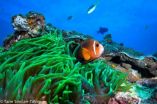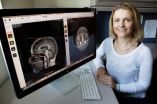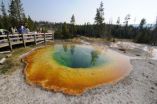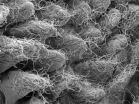(Press-News.org) Clownfish spend their entire lives nestling in the protective tentacles of host anemones, but new research shows that as babies they sometimes travel hundreds of kilometres across the open ocean. Although the process of long-distance dispersal by reef fish has been predicted, this is the first time that the high level exchange of offspring between distant populations has been observed.
Dr Steve Simpson, Senior Lecturer in Marine Biology and Global Change at the University of Exeter, and colleagues from the Australian Research Council Centre of Excellence for Coral Reef Studies (ARC COE CRS), Sultan Qaboos University (Oman) and the Centre National de la Recherche Scientifique (France) have published their findings on the dispersal of Omani clownfish larvae in the journal PLOS ONE.
The study found that six percent of the fish sampled had migrated over 400 km from one population to the other, which, contrary to the film Finding Nemo, is a process that only occurs during the ocean-going larval stage.
"This is an epic journey for these tiny week-old fish. When they arrive at the reef, they are less than a centimetre long, and only a few days old, so to travel hundreds of kilometres they must be riding ocean currents to assist their migration," said Dr Simpson.
Dr Simpson led a team of undergraduate and postgraduate students from the University of Edinburgh to collect the clownfish samples from throughout southern Oman.
"The southern coast of Oman is relatively isolated from the rest of the Arabian Peninsula so you find a lot of species there that you wouldn't find anywhere else in the world," said Dr Simpson. "There are only two coral reef systems along this coast, and they are separated by 400 km of surf beaches. In order to persist as a single species, we know Omani clownfish fish must occasionally migrate between these two populations."
The team used DNA fingerprinting to identify local, long-distant migrant, and hybrid individuals from populations throughout the entire Omani clownfish (Amphiprion omanensis) species range. Around 400 fish were harmlessly caught during 92 dives, and a small fin clip taken for DNA analysis before releasing fish back to their colonies.
"Just like accents that allow us to tell an Englishman from an American, fish populations develop their own genetic signatures," said co-author Hugo Harrison from the ARC COE CRS. "By looking at the signature of each fish we can tell whether it originated there or not. It's like finding an Englishman in New York, they stand out."
The DNA evidence identified that the majority of migrant fish had travelled from north to south and so, to test whether this was due to prevailing currents, the team developed an oceanographic model for the region.
"We found that the pattern of migration corresponded to the dominant ocean currents in the region that are driven by the winter monsoon," said co-author Michel Claereboudt from Sultan Qaboos University.
As well as migrants, second generation hybrids were also identified in both populations, showing that after dispersal migrants had joined and reproduced with local populations.
"This study is the furthest anyone has tracked the dispersal of coral reef fish, and it demonstrates that distant populations in the marine environment can be well connected," said Simpson. "Our ability to predict how far fish larvae disperse helps us to manage coral reef ecosystems. Understanding connectivity means we can protect populations that are most sensitive, harvest from populations that have a regular and consistent turn-over, and design coherent networks of marine protected areas".
The Omani coastline is an arid desert and the expedition took months of preparations for the harsh conditions. The 24 students and researchers were trained by Simpson and his dive instructors in SCUBA diving, emergency first aid and off-road driving. The team camped in areas that were isolated and dived at sites that had never been dived before.
"This was a turning point in my career," said co-author Hugo Harrison. "At that stage I'd never seen a coral reef or experienced how diverse these ecosystems can be. Many of us on this expedition went on to pursue careers in marine science, and my work now is focused on improving the management of these fragile ecosystems."
The project was highly commended by the Duke of Edinburgh, who invited the team to Buckingham Palace to hear more about the expedition.
INFORMATION:
Notes to editors
Long-distance dispersal via ocean currents connects Omani clownfish populations throughout entire species range by Steve Simpson, Hugo Harrison, Michel Claereboudt and Serge Planes is published in PLOS ONE.
The research and expedition was supported by Natural Environment Research Council, Royal Society, Ecole Pratique des Hautes Études, Davis Trust, University of Edinburgh Development Trust, Carnegie Trust, BS-AC Jubilee Trust, Weir Trust, Genetics Society, British Association and Shell Oman.
Contact
Dr Steve Simpson, Biosciences, University of Exeter; S.Simpson@exeter.ac.uk; +44 (0)7900 551883
Or Hugo Harrison, ARC Centre of Excellence for Coral Reef Studies, James Cook University; hugo.harrison@my.jcu.edu.au
For further information contact:
Dr Jo Bowler
University of Exeter Press Office
Office: +44 (0)1392 722062
Mobile: +44(0)7827 309 332
Twitter: @UoE_ScienceNews
j.bowler@exeter.ac.uk
or
Eleanor Gregory, Communications Manager
ARC Centre of Excellence for Coral Reef Studies
James Cook University, Townsville QLD, Australia
P: +61 7 4781 6067
E: eleanor.gregory@jcu.edu.au
W: http://www.coralcoe.org.au
About the University of Exeter
The University of Exeter is a Russell Group university and in the top one percent of institutions globally. It combines world-class research with very high levels of student satisfaction. Exeter has over 18,000 students and is ranked 8th in The Times and The Sunday Times Good University Guide league table, 10th in The Complete University Guide and 12th in the Guardian University Guide 2014. In the 2008 Research Assessment Exercise (RAE) 90% of the University's research was rated as being at internationally recognised levels and 16 of its 31 subjects are ranked in the top 10, with 27 subjects ranked in the top 20. Exeter was The Sunday Times University of the Year 2012-13.
The University has invested strategically to deliver more than £350 million worth of new facilities across its campuses in the last few years; including landmark new student services centres - the Forum in Exeter and The Exchange on the Penryn Campus in Cornwall, together with world-class new facilities for Biosciences, the Business School and the Environment and Sustainability Institute. There are plans for another £330 million of investment between now and 2016.
http://www.exeter.ac.uk
Expedition finds Nemo can travel great distances to connect populations
New research shows that as babies clownfish sometimes travel hundreds of kilometers across the open ocean
2014-09-17
ELSE PRESS RELEASES FROM THIS DATE:
Study links physical activity in older adults to brain white-matter integrity
2014-09-17
CHAMPAIGN, Ill. — Like everything else in the body, the white-matter fibers that allow communication between brain regions also decline with age. In a new study, researchers found a strong association between the structural integrity of these white-matter tracts and an older person's level of daily activity – not just the degree to which the person engaged in moderate or vigorous exercise, but also whether he or she was sedentary the rest of the time.
The study, reported in the journal PLOS ONE, tracked physical activity in 88 healthy but "low-fit" participants aged 60 ...
Targeted radiation, drug therapy combo less toxic for recurrent head, neck cancers
2014-09-17
SAN FRANCISCO, Sept. 17, 2014 – Patients with a recurrence of head and neck cancer who have previously received radiation treatment can be treated more quickly, safely and with fewer side effects with high doses of targeted radiation known as Stereotactic Body Radiation Therapy (SBRT) in combination with a drug that also carefully targets cancerous tumors. These findings from a UPMC CancerCenter study were presented today at the American Society of Radiation Oncology (ASTRO) annual meeting in San Francisco.
SBRT uses concentrated radiation beams in high doses to destroy ...
Nature's designs inspire research into new light-based technologies
2014-09-17
BELLINGHAM, Washington, USA -- "Nature has developed, very cleverly, some lessons on how to create the features that we desire in optical design," said Joseph Shaw, director of the Optical Technology Center at Montana State University. "As we explore surfaces and structures at the nanoscale, we'll discover them."
Some of those lessons were presented in San Diego in August during a conference called "The Nature of Light: Light in Nature" chaired by Shaw and Rongguang Liang of the University of Arizona College of Optical Sciences. The conference was part of SPIE Optics ...
In Joslin trial, Asian Americans lower insulin resistance on traditional diet
2014-09-17
BOSTON – September 17, 2014 – Why are Asian Americans at higher risk of developing type 2 diabetes than Caucasian Americans, and prone to develop the disease at lower body weights? One part of this puzzle may lie in the transition from traditional high-fiber, low-fat Asian diets to current westernized diets, which may pose extra risks for those of Asian heritage, says George King, M.D., Senior Vice President and Chief Scientific Officer at Joslin Diabetes Center and the senior author of the study.
A Joslin randomized clinical trial now has demonstrated that both Asian ...
Fighting parents hurt children's ability to recognize and regulate emotions
2014-09-17
Exposure to verbal and physical aggression between parents may hurt a child's ability to identify and control emotions, according to a longitudinal study led by NYU's Steinhardt School of Culture, Education, and Human Development.
The findings, which appear in the journal Development and Psychopathology, also suggest that household chaos and prolonged periods of poverty during early childhood may take a substantial toll on the emotional adjustment of young children.
"Our study points to ways in which aggression between parents may powerfully shape children's emotional ...
Persian Gulf states have new role to play in Israeli-Palestinian conflict resolution
2014-09-17
HOUSTON – (Sept. 17, 2014) – The shifting regional geopolitics of the Middle East have created new opportunities for the Persian Gulf states to engage in Arab-Israeli conflict resolution, according to a new paper from Rice University's Baker Institute for Public Policy.
"The Gulf States and Israeli-Palestinian Conflict Resolution," authored by Kristian Coates Ulrichsen, proposes a set of policy recommendations on how the Gulf states can engage with regional and international partners to create new pathways for action and cooperation. Ulrichsen is the fellow for the Middle ...
Why bioethics literacy matters
2014-09-17
From accessible and affordable health care to reproductive technologies, the justice and well-being of our society depend on the ability of people to identify key issues, articulate their values and concerns, deliberate openly and respectfully, and find the most defensible ways forward. But what are the best educational practices to support these societal conversations?
The Hastings Center and the Presidential Commission for the Study of Bioethical Issues have teamed up to publish a series of essays to highlight the best practices in teaching bioethics and to identify ...
Smallest known galaxy with a supermassive black hole
2014-09-17
SALT LAKE CITY, Sept. 17, 2014 – A University of Utah astronomer and his colleagues discovered that an ultracompact dwarf galaxy harbors a supermassive black hole – the smallest galaxy known to contain such a massive light-sucking object. The finding suggests huge black holes may be more common than previously believed.
"It is the smallest and lightest object that we know of that has a supermassive black hole," says Anil Seth, lead author of an international study of the dwarf galaxy published in Thursday's issue of the journal Nature. "It's also one of the most black ...
Gut bacteria, artificial sweeteners and glucose intolerance
2014-09-17
Artificial sweeteners, promoted as aids to weight loss and diabetes prevention, could actually hasten the development of glucose intolerance and metabolic disease; and they do it in a surprising way: by changing the composition and function of the gut microbiota – the substantial population of bacteria residing in our intestines. These findings, the results of experiments in mice and humans, were published today in Nature. Among other things, says Dr. Eran Elinav of the Weizmann Institute's Immunology Department, who led this research together with Prof. Eran Segal of Computer ...
New branch added to European family tree
2014-09-17
The setting: Europe, about 7,500 years ago.
Agriculture was sweeping in from the Near East, bringing early farmers into contact with hunter-gatherers who had already been living in Europe for tens of thousands of years.
Genetic and archaeological research in the last 10 years has revealed that almost all present-day Europeans descend from the mixing of these two ancient populations. But it turns out that's not the full story.
Researchers at Harvard Medical School and the University of Tübingen in Germany have now documented a genetic contribution from a third ancestor: ...
LAST 30 PRESS RELEASES:
Making lighter work of calculating fluid and heat flow
Normalizing blood sugar can halve heart attack risk
Lowering blood sugar cuts heart attack risk in people with prediabetes
Study links genetic variants to risk of blinding eye disease in premature infants
Non-opioid ‘pain sponge’ therapy halts cartilage degeneration and relieves chronic pain
AI can pick up cultural values by mimicking how kids learn
China’s ecological redlines offer fast track to 30 x 30 global conservation goal
Invisible indoor threats: emerging household contaminants and their growing risks to human health
Adding antibody treatment to chemo boosts outcomes for children with rare cancer
Germline pathogenic variants among women without a history of breast cancer
Tanning beds triple melanoma risk, potentially causing broad DNA damage
Unique bond identified as key to viral infection speed
Indoor tanning makes youthful skin much older on a genetic level
Mouse model sheds new light on the causes and potential solutions to human GI problems linked to muscular dystrophy
The Journal of Nuclear Medicine ahead-of-print tip sheet: December 12, 2025
Smarter tools for peering into the microscopic world
Applications open for funding to conduct research in the Kinsey Institute archives
Global measure underestimates the severity of food insecurity
Child survivors of critical illness are missing out on timely follow up care
Risk-based vs annual breast cancer screening / the WISDOM randomized clinical trial
University of Toronto launches Electric Vehicle Innovation Ontario to accelerate advanced EV technologies and build Canada’s innovation advantage
Early relapse predicts poor outcomes in aggressive blood cancer
American College of Lifestyle Medicine applauds two CMS models aligned with lifestyle medicine practice and reimbursement
Clinical trial finds cannabis use not a barrier to quitting nicotine vaping
Supplemental nutrition assistance program policies and food insecurity
Switching immune cells to “night mode” could limit damage after a heart attack, study suggests
URI-based Global RIghts Project report spotlights continued troubling trends in worldwide inhumane treatment
Neutrophils are less aggressive at night, explaining why nighttime heart attacks cause less damage than daytime events
Menopausal hormone therapy may not pose breast cancer risk for women with BRCA mutations
Mobile health tool may improve quality of life for adolescent and young adult breast cancer survivors
[Press-News.org] Expedition finds Nemo can travel great distances to connect populationsNew research shows that as babies clownfish sometimes travel hundreds of kilometers across the open ocean







